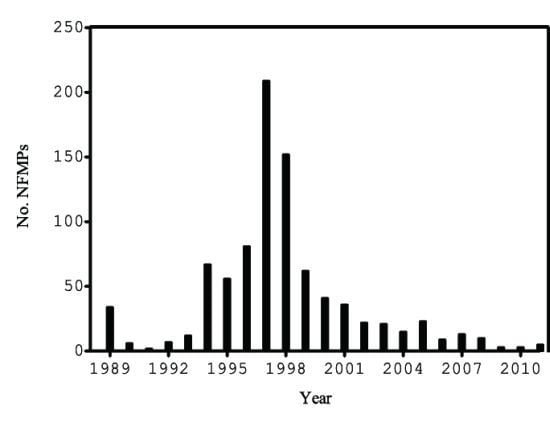Historical Patterns of Natural Forest Management in Costa Rica: The Good, the Bad and the Ugly
Abstract
:1. Introduction
2. Experimental Section
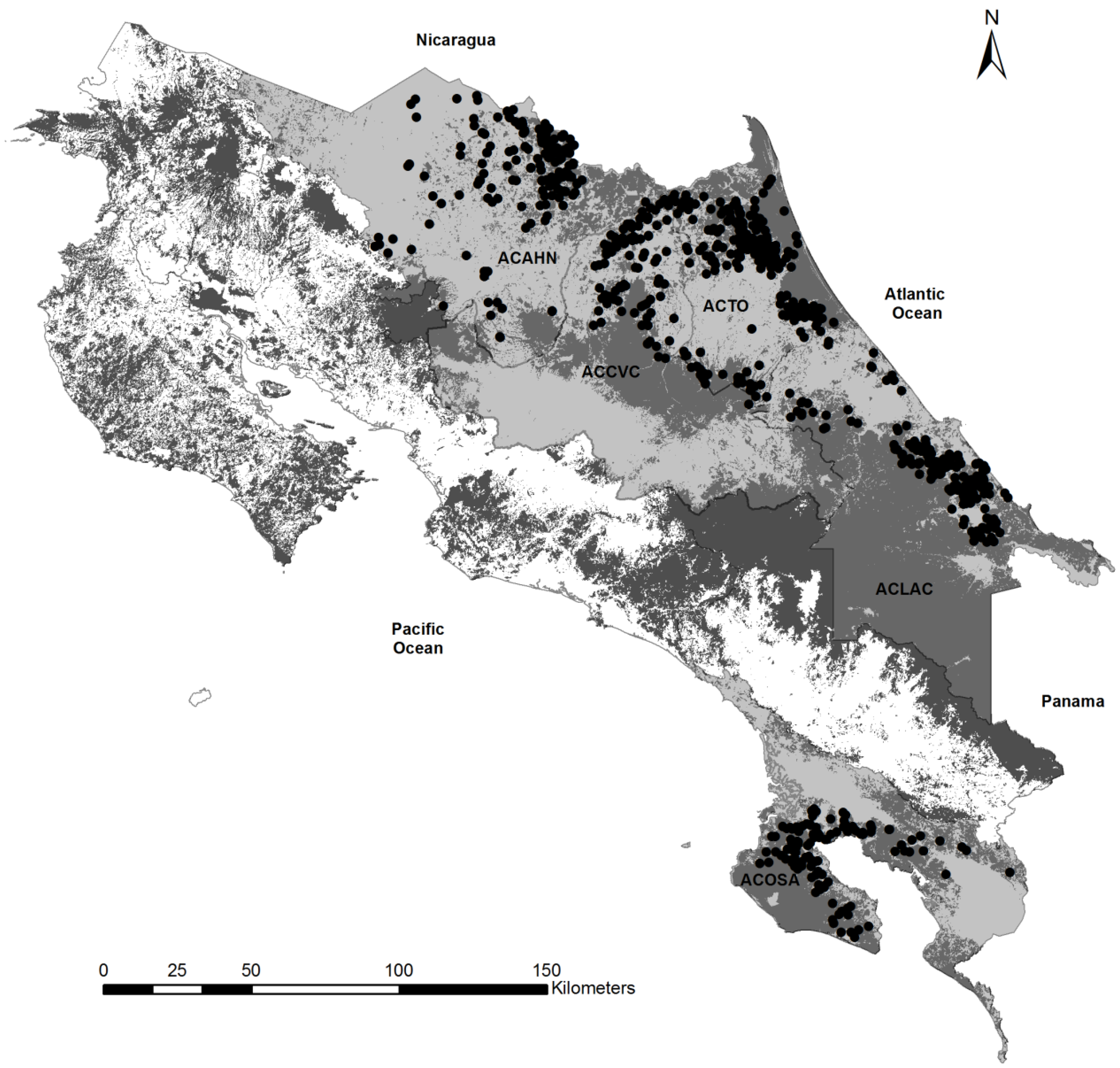
| ACAHN | Total Property Area | Managed Area | Productive Area | Protected Zone |
|---|---|---|---|---|
| Mean | 125.7 | 45.7 | 35.6 | 6.3 |
| Median | 79.1 | 30.7 | 25.0 | 1.8 |
| Standard deviation | 210.6 | 47.4 | 35.2 | 11.6 |
| Coefficient of variation | 1.7 | 1.0 | 1.0 | 1.8 |
| ACCVC | ||||
| Mean | 97.0 | 40.0 | 28.1 | 8.7 |
| Median | 68.3 | 31.5 | 20.0 | 4.1 |
| Standard deviation | 94.3 | 33.8 | 25.8 | 13.8 |
| Coefficient of variation | 0.97 | 0.8 | 0.9 | 1.6 |
| ACLA-C | ||||
| Mean | 69.5 | 37.1 | 26.5 | 9.5 |
| Median | 49.2 | 25.0 | 17.4 | 4.0 |
| Standard deviation | 64.2 | 41.5 | 28.1 | 18.2 |
| Coefficient of variation | 0.9 | 1.1 | 1.1 | 1.9 |
| ACOSA | ||||
| Mean | 78.9 | 40.9 | 21.3 | 19.2 |
| Median | 53.4 | 27.0 | 12.0 | 11.0 |
| Standard deviation | 80.7 | 42.2 | 24.3 | 22.0 |
| Coefficient of variation | 1.02 | 1.03 | 1.1 | 1.1 |
| ACTO | ||||
| Mean | 117.3 | 51.0 | 40.3 | 9.1 |
| Median | 63.5 | 27.0 | 20.5 | 2.0 |
| Standard deviation | 207.1 | 61.9 | 50.2 | 25.0 |
| Coefficient of variation | 1.8 | 1.2 | 1.2 | 2.8 |
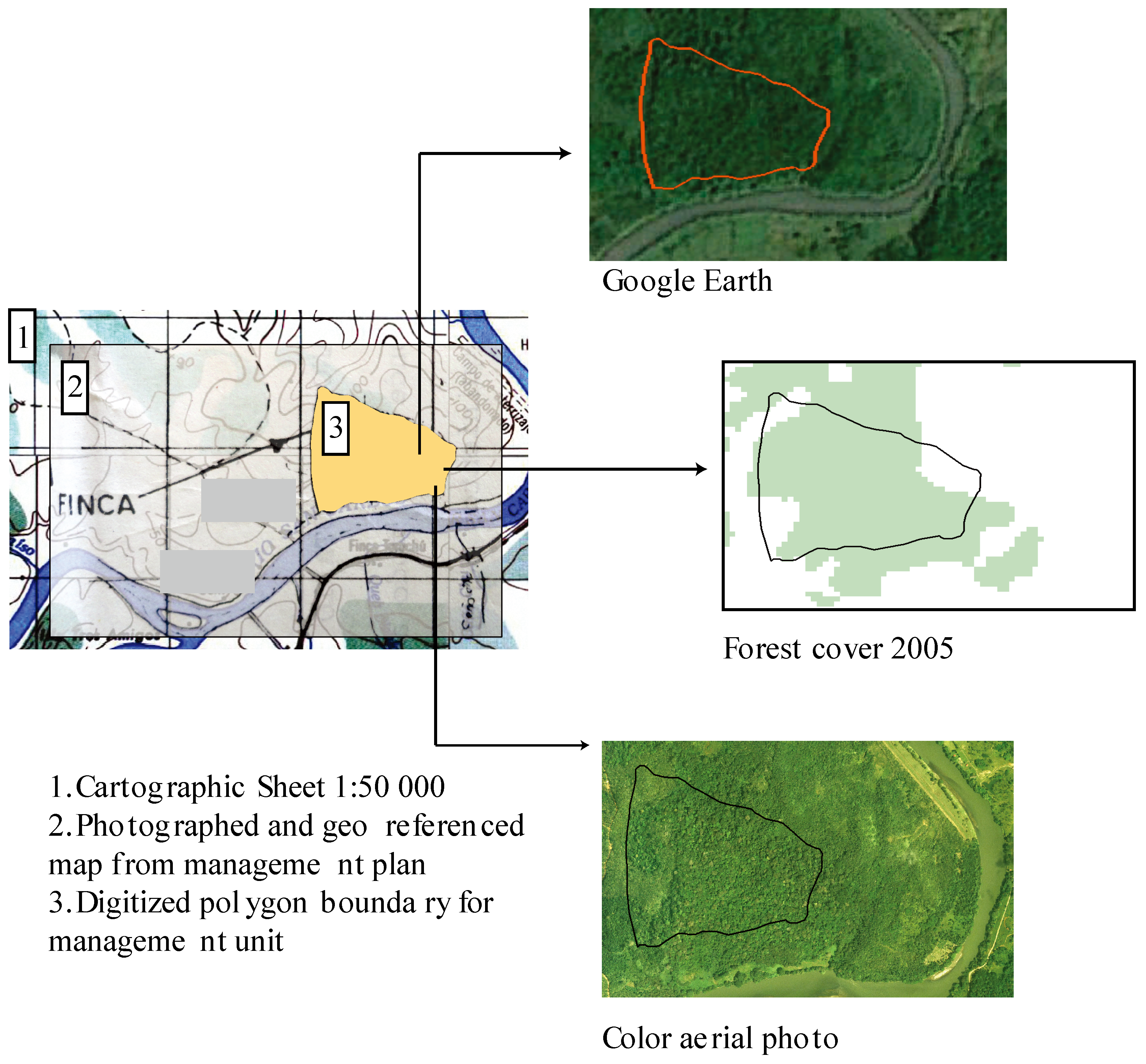
3. Results and Discussion
3.1. Historical Forest Management Trends
3.2. The Good: An Assessment of Forest Fate
| Category | ACAHN (n = 72) | ACCVC (n = 57) | ACTO (n = 161) | ACLA-C (n = 74) | ACOSA (n = 58) |
|---|---|---|---|---|---|
| Agreement with original plan (%) | 90 | 70 | 71 | 84 | 81 |
| Partial Agreement with original plan (%) | 10 | 30 | 21 | 12 | 17 |
| No Agreement with original plan (%) | 0 | 0 | 8 | 4 | 2 |
3.3. The Bad: Relationship between Forest Management Location and Forest Fragmentation
| Metric | ACAHN | ACCVC | ACLA-C | ACOSA | ACTO |
|---|---|---|---|---|---|
| Forest Area (ha) | 159,846 | 105,544 | 46,6324 | 220,991 | 143,108 |
| % Land | 24 | 48 | 75 | 52 | 47 |
| No. Patches | 2241 | 761 | 610 | 708 | 1144 |
| Large Patch Index | 5.4 | 27.4 | 69.7 | 38.9 | 32.1 |
| Mean patch area (ha) | 67 | 128 | 553 | 271 | 117 |
| Median patch area (ha) | 7 | 7 | 5 | 6 | 6 |
| Patch range (ha) | 36,272 | 60,462 | 432,294 | 165,408 | 98,044 |
| Patch area stand. Dev. | 1069 | 2140 | 14,878 | 5832 | 2817 |
| Shape Index Mean | 1.81 | 2.08 | 1.96 | 1.88 | 1.99 |
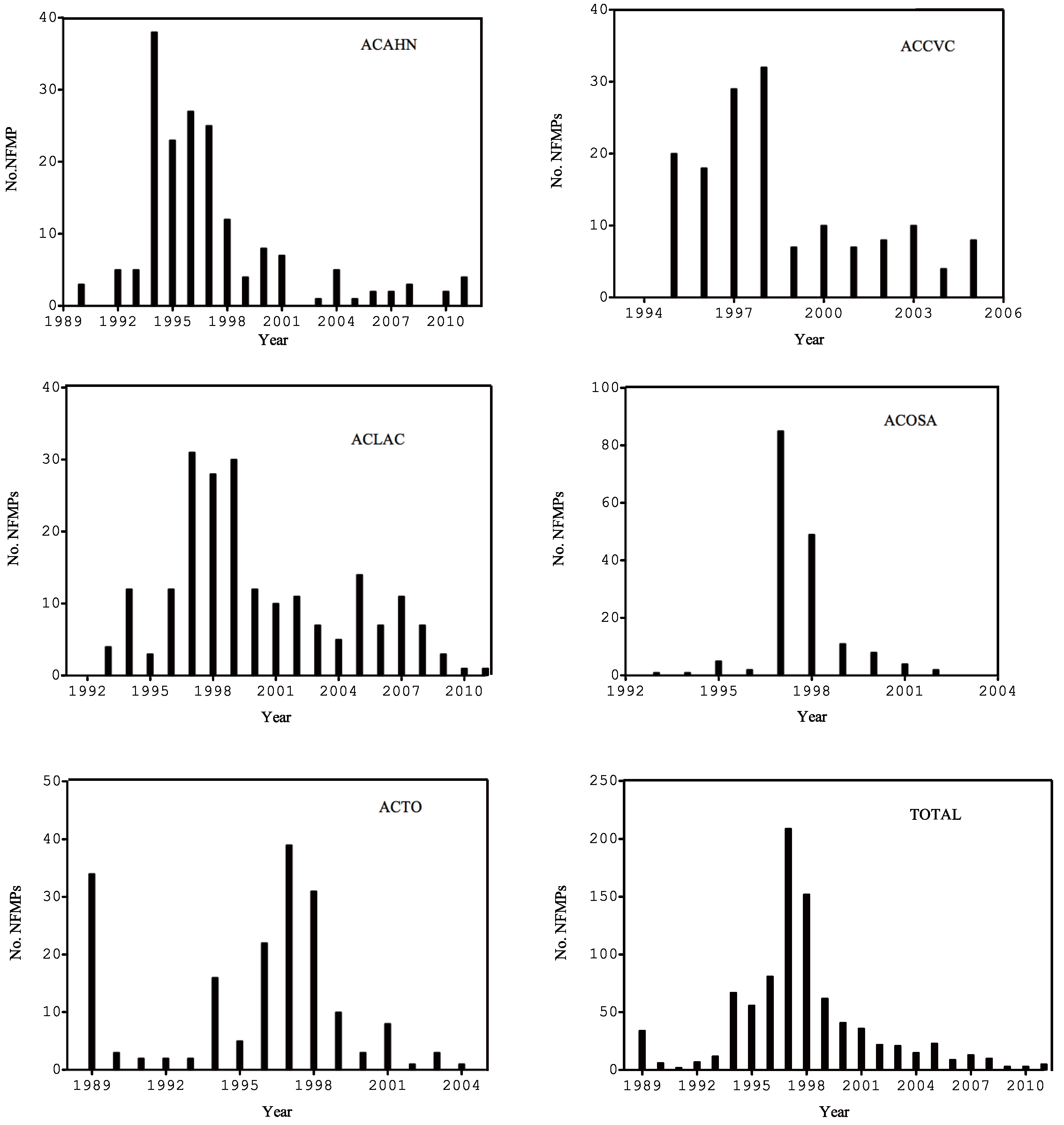


3.4. The Ugly: a Preliminary Discussion on Polycyclic Management in Costa Rica
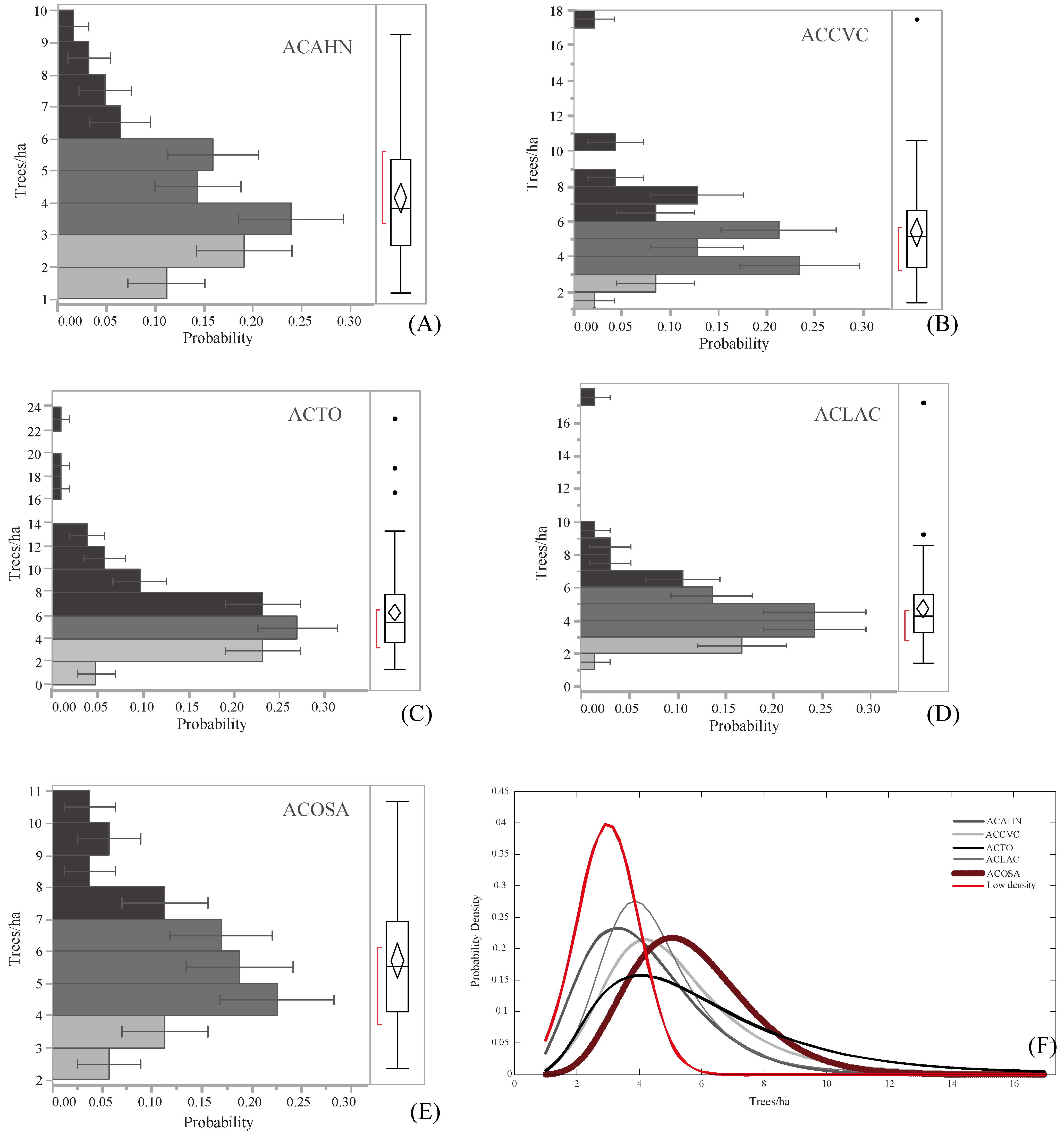
4. Conclusions
Acknowledgments
Author Contributions
Conflicts of Interest
References
- Rodrigues, A.S.L.; Andelman, S.J.; Bakarr, M.I.; Boitani, L.; Brooks, T.M.; Cowling, R.M.; Fishpool, L.D.C.; da Fonseca, G.A.B.; Gaston, K.J.; Hoffmann, M.; et al. Effectiveness of the global protected area network in representing species diversity. Nature 2004, 428, 640–643. [Google Scholar] [CrossRef] [PubMed]
- Chazdon, R.L. Ecology-tropical forests-log ’em or leave ’em? Science 1998, 281, 1295–1296. [Google Scholar] [CrossRef]
- Johns, A.G. Timber Production and Biodiversity in the Tropical Rain Forests; Cambridge University Press: Cambridge, UK, 1997. [Google Scholar]
- Cannon, C.H.; Peart, D.R.; Leighton, M. Tree species diversity in commercially logged bornean rainforest. Science 1998, 281, 1366–1368. [Google Scholar] [CrossRef] [PubMed]
- Dunn, R.R. Managing the tropical landscape: A comparison of the effects of logging and forest conversion to agriculture on ants, birds, and Lepidoptera. For. Ecol. Manag. 2004, 191, 215–224. [Google Scholar] [CrossRef]
- Douglas, I.; Spencer, T.; Greer, T.; Bidin, K.; Sinun, W.; Meng, W.W. The impact of selective commercial logging on stream hydrology, chemistry and sediment loads in the Ulu Segama rain forest, Sabah, Malaysia. Philos. Trans. Biol. Sci. 1992, 335, 397–406. [Google Scholar] [CrossRef]
- Nepstad, D.C.; Verssimo, A.; Alencar, A.; Nobre, C.; Lima, E.; Lefebvre, P.; Schlesinger, P.; Potter, C.; Moutinho, P.; Mendoza, E.; et al. Large-scale impoverishment of Amazonian forests by logging and fire. Nature 1999, 398, 505–508. [Google Scholar] [CrossRef]
- Broadbent, E.N.; Asner, G.P.; Keller, M.; Knapp, D.E.; Oliveira, P.J.C.; Silva, J.N. Forest fragmentation and edge effects from deforestation and selective logging in the Brazilian Amazon. Biol. Conserv. 2008, 141, 1745–1757. [Google Scholar] [CrossRef]
- Putz, F.E.; Blate, G.M.; Redford, K.H.; Fimbel, R.; Robinson, J. Tropical forest management and conservation of biodiversity: An overview. Conser. Biol. 2001, 15, 7–20. [Google Scholar] [CrossRef]
- Blaser, J.; Sarre, A.; Poore, D.; Johnson, S. Status of Tropical Forest Management 2011; ITTO: Yokohama, Japan, 2011; p. 418. [Google Scholar]
- McGinley, K.; Finegan, B. Criterios e indicadores para evaluar la sostenibilidad ecológica: Un conjunto integrado para bosques manejados en Costa Rica. Rev. For. Centroam. 2001, 34, 23–27. [Google Scholar]
- ITTO. Revised ITTO Criteria and Indicators for Sustainable Management of Tropical Forests Including Reporting Format; ITTO: Yokohama, Japan, 2005; p. 40. [Google Scholar]
- De Camino, R.; Segura, O.; Arias, L.G.; Perez, I. Costa Rica: Forest Strategy and the Evolution of Land Use; The World Bank: Washington, DC, USA, 2000; p. 151. [Google Scholar]
- Svob, S.; Arroyo-Mora, J.P.; Kalacska, M. The development of a forestry geodatabase for natural forest management plans in Costa Rica. For. Ecol. Manag. 2014. [Google Scholar] [CrossRef]
- Arroyo-Mora, J.P.; Chazdon, R.; Kalacska, M.; Obando, G.; Aguilar, L.; Salas, L.F. Development of a Forest Management GIS for Costa Rica, a Case Study for the Central Volcanic Cordillera Conservation Area: Management Trends, Lessons and Potential Uses in Ecological Research and Conservation Planning. In Proceedings of the XIII World Forestry Congress, Buenos Aires, Argentina; 2009. [Google Scholar]
- Nasi, R.; Putz, F.; Pacheco, P.; Wunder, S.; Anta, S. Sustainable forest management and carbon in tropical Latin America: The case for REDD+. Forests 2011, 2, 200–217. [Google Scholar]
- McGarigal, K.; Marks, B.J. Fragstats: Spatial Pattern Analysis Program for Quantifying Landscape Structure; U.S. Department of Agriculture, Forest Service, Pacific Northwest Research Station: Portland, OR, USA, 2005; p. 122.
- SINAC. Estandares de sostenibilidad para manejo de bosques naturales: Codigo de practicas. In Resolucion R-SINAC-021-2009; La Gaceta: San Jose, Costa Rica, 2009. [Google Scholar]
- Clark, D.A.; Piper, S.C.; Keeling, C.D.; Clark, D.B. Tropical rain forest tree growth and atmospheric carbon dynamics linked to interannual temperature variation during 1984–2000. Proc. Nat. Acad. Sci. 2003, 100, 5852–5857. [Google Scholar] [CrossRef] [PubMed]
- Phillips, O.L.; Aragão, L.E.O.C.; Lewis, S.L.; Fisher, J.B.; Lloyd, J.; López-González, G.; Malhi, Y.; Monteagudo, A.; Peacock, J.; Quesada, C.A.; et al. Drought sensitivity of the Amazon rainforest. Science 2009, 323, 1344–1347. [Google Scholar] [CrossRef] [PubMed] [Green Version]
- Arroyo-Mora, J.P.; Kalacska, M.; Chazdon, R.L.; Civco, D.; Obando, G.; Sanchum, A.A. Assessing recovery following selective logging of lowland tropical forests based on hyperspectral imagery. In Hyperspectral Remote Sensing of Tropical and Sub-Tropical Forests; Kalacska, M., Sanchez-Azofeifa, G.A., Eds.; Taylor and Francis Group-CRC Press: Boca Raton, FL, USA, 2008; pp. 193–212. [Google Scholar]
- Calvo-Alvarado, J.C.; Sanchez-Azofeifa, A. Estudio de Monitoreo de Cobertura Forestal de Costa Rica 2005; FONAFIFO: San Jose, Costa Rica, 2007. [Google Scholar]
- ESRI. Arcgis Desktop: Release 10.1, Environmental Systems Research Institute: Redlands, CA, USA, 2011.
- Arroyo-Mora, J.P.; Sánchez-Azofeifa, G.A.; Rivard, B.; Calvo, J.C.; Janzen, D.H. Dynamics in landscape structure and composition for the Chorotega region, Costa Rica from 1960 to 2000. Agric. Ecosyst. Environ. 2005, 106, 27–39. [Google Scholar]
- Sánchez-Azofeifa, G.A.; Harriss, R.C.; Skole, D.L. Deforestation in Costa Rica: A quantitative analysis using remote sensing imagery. Biotropica 2001, 33, 378–384. [Google Scholar]
- Sanchez-Azofeifa, G.A.; Rivard, B.; Calvo, J.; Moorthy, I. Dynamics of tropical deforestation around national parks: Remote sensing of forest change on the Osa Peninsula of Costa Rica. Mt. Res. Dev. 2002, 22, 352–358. [Google Scholar] [CrossRef]
- Hanson, T.; Brunsfeld, S.; Finegan, B. Variation in seedling density and seed predation indicators for the emergent tree Dipteryx panamensis in continuous and fragmented rain forest. Biotropica 2006, 38, 770–774. [Google Scholar] [CrossRef]
- Guariguata, M.R.; Claire, H.A.; Jones, G. Tree seed fate in a logged and fragmented forest landscape, northeastern Costa Rica1. Biotropica 2002, 34, 405–415. [Google Scholar] [CrossRef]
- Sist, P.; Ferreira, F.N. Sustainability of reduced-impact logging in the eastern Amazon. For. Ecol. Manag. 2007, 243, 199–209. [Google Scholar] [CrossRef]
- Putz, F.E.; Sist, P.; Fredericksen, T.; Dykstra, D. Reduced-impact logging: Challenges and opportunities. For. Ecol. Manag. 2008, 256, 1427–1433. [Google Scholar] [CrossRef]
- Sist, P.; Mazzei, L.; Blanc, L.; Rutishauser, E. Large trees as key elements of carbon storage and dynamics after selective logging in the eastern Amazon. For. Ecol. Manag. 2014, 318, 103–109. [Google Scholar] [CrossRef]
- ITTO. Status of Tropical Forest Management 2005; ITTO: Yokohama, Japan, 2007. [Google Scholar]
- Asner, G.P.; Knapp, D.E.; Broadbent, E.N.; Oliveira, P.J.C.; Keller, M.; Silva, J.N. Selective logging in the Brazilian Amazon. Science 2005, 310, 480–482. [Google Scholar] [CrossRef] [PubMed]
- Phillips, P.L. Key Vegetation Types for the Osa Peninsula, Costa Rica; Center for Space Research, The Nature Conservancy: Austin, TX, USA, 1993; p. 20. [Google Scholar]
- Miranda, M.; Dieperink, C.; Glasbergen, P. Costa rican environmental service payments: The use of a financial instrument in participatory forest management. Environ. Manag. 2006, 38, 562–571. [Google Scholar]
- Barrantes, G.; Jiménez, Q.; Lobo, J.; Maldonado, T.; Quesada, M.; Quesada, R. Evaluación de Los Planes de Manejo Forestales Autorizados en el Período 1997–1999 en la Península de Osa. Cumplimiento de Normas Técnicas, Ambientales e Impacto Sobre el Bosque Natural; Fundación Cecropia: San Jose, Costa Rica, 1999. [Google Scholar]
- Pagiola, S. Payments for environmental services in Costa Rica. Ecol. Econ. 2008, 65, 712–724. [Google Scholar] [Green Version]
- Daniels, A.E.; Bagstad, K.; Esposito, V.; Moulaert, A.; Rodriguez, C.M. Understanding the impacts of Costa Rica’S pes: Are we asking the right questions? Ecol. Econ. 2010, 69, 2116–2126. [Google Scholar]
- Asner, G.P.; Broadbent, E.N.; Oliveira, P.J.C.; Keller, M.; Knapp, D.E.; Silva, J.N.M. Condition and fate of logged forests in the Brazilian Amazon. Proc. Natl. Acad. Sci. USA. 2006, 103, 12947–12950. [Google Scholar] [PubMed]
- Gaveau, D.L.A.; Kshatriya, M.; Sheil, D.; Sloan, S.; Molidena, E.; Wijaya, A.; Wich, S.; Ancrenaz, M.; Hansen, M.; Broich, M.; et al. Reconciling forest conservation and logging in Indonesian Borneo. PLoS One 2013, 8. [Google Scholar] [CrossRef] [PubMed]
- Bonnell, T.R.; Reyna-Hurtado, R.; Chapman, C.A. Post-logging recovery time is longer than expected in an east African tropical forest. For. Ecol. Manag. 2011, 261, 855–864. [Google Scholar] [CrossRef]
- Laufer, J.; Michalski, F.; Peres, C.A. Assessing sampling biases in logging impact studies in tropical forests. Trop. Conserv. Sci. 2013, 6, 16–34. [Google Scholar]
- Fagan, M.E.; DeFries, R.S.; Sesnie, S.E.; Arroyo, J.P.; Walker, W.; Soto, C.; Chazdon, R.L.; Sanchun, A. Land cover dynamics following a deforestation ban in northern Costa Rica. Environ. Res. Lett. 2013, 8, 034017. [Google Scholar] [CrossRef]
- Turner, I.M. Species loss in fragments of tropical rain forest: A review of the evidence. J. Appl. Ecol. 1996, 33, 200–209. [Google Scholar] [CrossRef]
- Metzger, J.P. Tree functional group richness and landscape structure in a Brazilian tropical fragmented landscape. Ecol. Appl. 2000, 10, 1147–1161. [Google Scholar] [CrossRef]
- Zbinden, S.; Lee, D.R. Paying for environmental services: An analysis of participation in Costa Rica’S PSA program. World Dev. 2005, 33, 255–272. [Google Scholar] [CrossRef]
- Valverde, O. Application of a timber extraction vulnerability index in a humid tropical forest. Rev. For. Mesoam. Kuru 2006, 3. [Google Scholar]
- Howard, A.F. A linear programming model for predicting the sustainable yield of timber from a community forest on the Osa Peninsula of Costa Rica. For. Ecol. Manag. 1993, 61, 29–43. [Google Scholar] [CrossRef]
- West, T.A.P.; Vidal, E.; Putz, F.E. Forest biomass recovery after conventional and reduced-impact logging in Amazonian Brazil. For. Ecol. Manag. 2014, 314, 59–63. [Google Scholar] [CrossRef]
- Huang, M.; Asner, G.P. Long-term carbon loss and recovery following selective logging in Amazon forests. Glob. Biogeochem. Cycles 2010, 24, GB3028. [Google Scholar] [CrossRef]
- Putz, F.E.; Zuidema, P.A.; Synnott, T.; Peña-Claros, M.; Pinard, M.A.; Sheil, D.; Vanclay, J.K.; Sist, P.; Gourlet-Fleury, S.; Griscom, B.; et al. Sustaining conservation values in selectively logged tropical forests: The attained and the attainable. Conserv. Lett. 2012, 5, 296–303. [Google Scholar] [CrossRef]
- Svob, S.; Arroyo-Mora, J.P.; Kalacska, M. An assessment of wood density and aboveground biomass variability using pre-felling inventory data in Costa Rica. Carbon Balance Manag. 2014; Under review. [Google Scholar]
- Finegan, B. Pattern and process in neotropical secondary rain forests: The first 100 years of succession. Trends Ecol. Evol. 1996, 11, 119–124. [Google Scholar] [CrossRef] [PubMed]
- Finegan, B.; Delgado, D.; Hayes, D.J.; Gretzinger, S. El monitoreo ecológico como herramienta de manejo forestal sostenible: Consideraciones básicas y propuesta metodológica con énfasis en bosques de alto valor para la conservación certificados bajo el marco del fsc. Recur. Nat. Ambiente 2004, 42, 29–42. [Google Scholar]
© 2014 by the authors; licensee MDPI, Basel, Switzerland. This article is an open access article distributed under the terms and conditions of the Creative Commons Attribution license (http://creativecommons.org/licenses/by/3.0/).
Share and Cite
Arroyo-Mora, J.P.; Svob, S.; Kalacska, M.; Chazdon, R.L. Historical Patterns of Natural Forest Management in Costa Rica: The Good, the Bad and the Ugly. Forests 2014, 5, 1777-1797. https://doi.org/10.3390/f5071777
Arroyo-Mora JP, Svob S, Kalacska M, Chazdon RL. Historical Patterns of Natural Forest Management in Costa Rica: The Good, the Bad and the Ugly. Forests. 2014; 5(7):1777-1797. https://doi.org/10.3390/f5071777
Chicago/Turabian StyleArroyo-Mora, J. Pablo, Sienna Svob, Margaret Kalacska, and Robin L. Chazdon. 2014. "Historical Patterns of Natural Forest Management in Costa Rica: The Good, the Bad and the Ugly" Forests 5, no. 7: 1777-1797. https://doi.org/10.3390/f5071777




